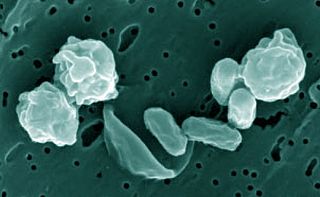
Geobacillus stearothermophilus is a rod-shaped, Gram-positive bacterium and a member of the phylum Bacillota. The bacterium is a thermophile and is widely distributed in soil, hot springs, ocean sediment, and is a cause of spoilage in food products. It will grow within a temperature range of 30 to 75 °C. Some strains are capable of oxidizing carbon monoxide aerobically. It is commonly used as a challenge organism for sterilization validation studies and periodic check of sterilization cycles. The biological indicator contains spores of the organism on filter paper inside a vial. After sterilizing, the cap is closed, an ampule of growth medium inside of the vial is crushed and the whole vial is incubated. A color and/or turbidity change indicates the results of the sterilization process; no change indicates that the sterilization conditions were achieved, otherwise the growth of the spores indicates that the sterilization process has not been met. Recently a fluorescent-tagged strain, Rapid Readout(tm), is being used for verifying sterilization, since the visible blue fluorescence appears in about one-tenth the time needed for pH-indicator color change, and an inexpensive light sensor can detect the growing colonies.

Bacillus odysseyi is a Gram-positive, aerobic, rod-shaped, round-spore- and endospore-forming eubacterium of the genus Bacillus. This novel species was discovered by scientist Myron T. La Duc of NASA’s Biotechnology and Planetary Protection Group, a unit whose purpose is to clean and sterilize spacecraft so as not to have microorganisms contaminate other celestial bodies or foreign microorganisms contaminate Earth, on the surface of the Mars Odyssey in a clean room at the Jet Propulsion Laboratory in La Cañada Flintridge before the spacecraft was launched to space. La Duc named the bacterium Bacillus odysseyi sp. nov. after the Odyssey mission. It had apparently evolved to live in the sparse environment of a clean room, and its secondary spore coat makes it especially resistant to radiation.
Bacillus arseniciselenatis is a bacterium first isolated from Mono Lake, California. It is notable for respiring oxyanions of selenium and arsenic. It is spore-forming, rod-shaped and alkaliphile, its type strain being E1H. It is a strict anaerobe.
Gracilibacillus is a genus of bacteria within the phylum Bacillota. Species within this genus are generally halotolerant.
Virgibacillus is a genus of Gram-positive, rod-shaped (bacillus) bacteria and a member of the phylum Bacillota. Virgibacillus species can be obligate aerobes, or facultative anaerobes and catalase enzyme positive. Under stressful environmental conditions, the bacteria can produce oval or ellipsoidal endospores in terminal, or sometimes subterminal, swollen sporangia. The genus was recently reclassified from the genus Bacillus in 1998 following an analysis of the species V. pantothenticus. Subsequently, a number of new species have been discovered or reclassified as Virgibacillus species.
Sporosarcina globispora, formerly known as Bacillus globisporus, is a Gram-positive, aerobic, round spore-forming bacillus. Strains of this species were originally described in 1967 and were found to be fairly similar to the species Bacillus pantothenticus. The species was later reassigned to the genus Sporosarcina along with the species Bacillus psychrophilus and Bacillus pasteurii.
Jeotgalibacillus alimentarius is a bacterium, the type species of its genus. It was first isolated from jeotgal, hence its name. It is a moderately halophilic, round-endospore-forming bacterium, with type strain YKJ-13T.
Bacillus azotoformans is a species of bacteria within the genus Bacillus. Novel nitrite reductases have been isolated from strains of this species.
Virgibacillus salexigens is a species of Gram-positive bacteria.
Sphingomonas oryziterrae is a Gram-negative and rod-shaped bacteria from the genus of Sphingomonas which has been isolated from rhizosphere soil from rice fields in Jinju in Korea.
Bhargavaea beijingensis is a Gram-positive, moderately halotolerant and non-motile bacterium from the genus of Bhargavaea which has been isolated from the root of a ginseng plant.
Bhargavaea ginsengi is a Gram-positive, moderately halotolerant and non-motile bacterium from the genus of Bhargavaea which has been isolated from the roots of a ginseng plant in Beijing in China.
Solibacillus is a genus of Gram positive, rod shaped, spore-forming bacteria.
Anaerobacillus is a genus of bacteria from the family of Bacillaceae.
Anaerobacillus alkalidiazotrophicus is a strictly anaerobic, diazotrophic and spore-forming bacterium from the genus of Anaerobacillus which has been isolated from soil from Choibalsan in Mongolia.
Psychrobacillus psychrodurans is a psychrotolerant bacterium from the genus of Psychrobacillus which has been isolated from garden soil from Egypt.
Salibacterium halochares is a Gram-positive, aerobic and halophilic bacterium from the genus of Salibacterium which has been isolated from a saltern from Mesolongi in Greece.
Salibacterium qingdaonense is a Gram-positive and haloalkaliphilic bacterium from the genus of Salibacterium which has been isolated from crude sea salt near Qingdao in China.
Salipaludibacillus neizhouensis is a Gram-positive, facultatively alkaliphilic, slightly halophilic, endospore-forming, rod-shaped, aerobic and non-motil bacterium from the genus of Salipaludibacillus which has been isolated from a sea anemone from Neizhou Bay from the South China Sea.
Schinkia is a genus of Gram-positive rod-shaped bacteria in the family Bacillaceae from the order Bacillales. The type species of this genus is Schinkia azotoformans.

